There are many types of diodes, and this article describes the different types, their applications, and their symbols. This component is essential to electronic circuits, and we will discuss it in detail.
Diodes are electronic components (semiconductors) that allow current to pass only in one direction.
Diodes are two-terminal electronic components that act like a normal switch. There is only one direction in which current can flow through them. The semiconductor materials used in these diodes are gallium arsenide, silicon, and germanium.
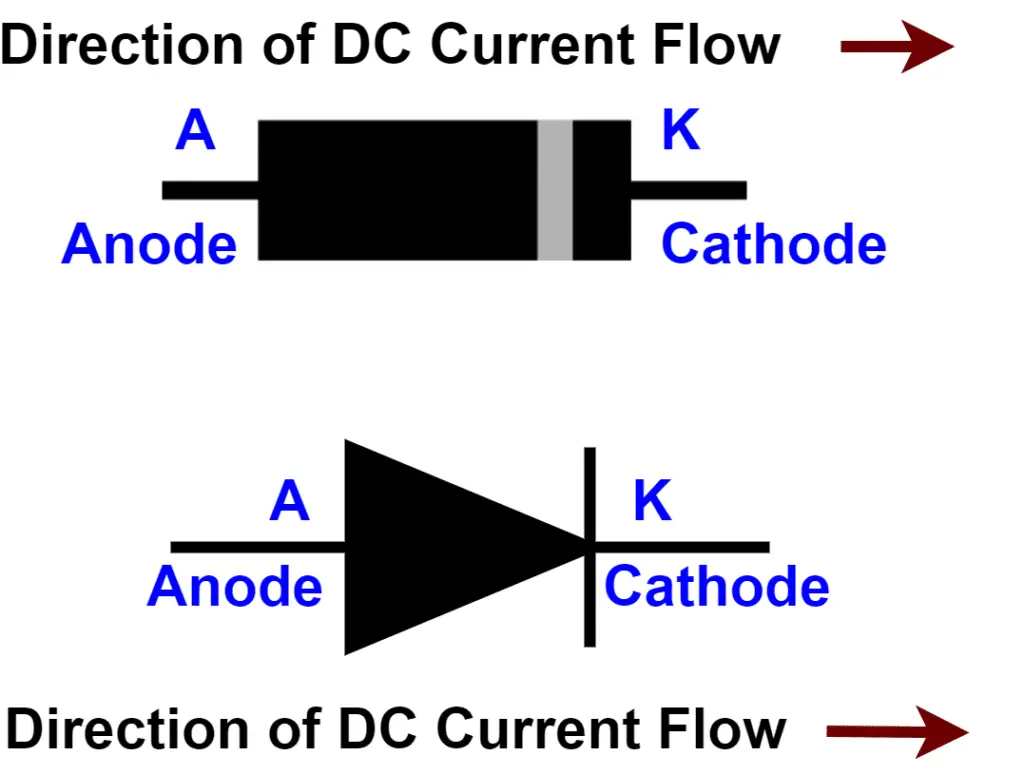
American system and conventional system
Diodes have two types of identification codes: the American and the conventional system.
In the American system, the code begins with 1N followed by the diode’s serial number, for example 1N4001, 1N4007etc.,
The conventional system begins with two letters. The first one indicates the semiconductor material (A = germanium, B = silicon) and the second letter indicates the diode applications (A = signal diode, Y = rectifier diode, Z = Zener diode).
What are forward bias and Reverse bias in Diode?
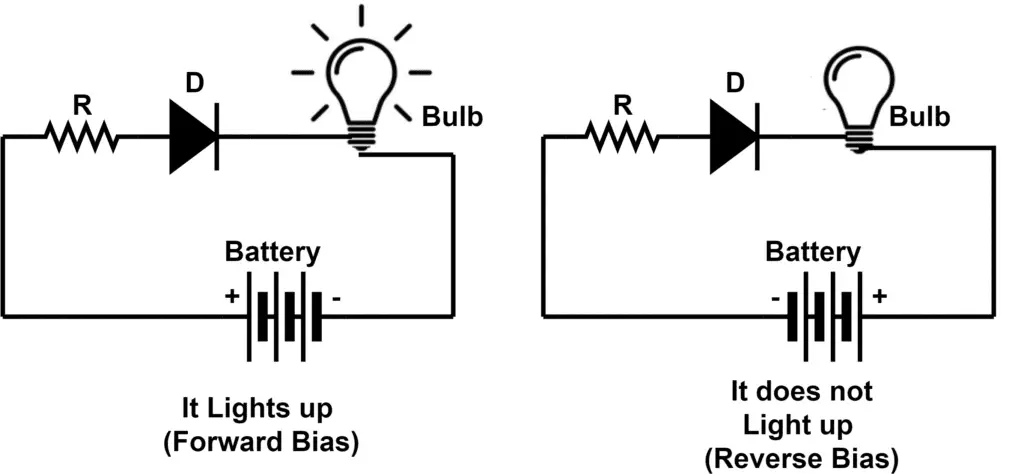
Diodes have two terminals. One terminal is the anode and the other one is the cathode. There are two ways in which a diode can operate based on the potential difference between these two terminals.
A forward-based diode has a higher anode potential than its cathode, allowing current to flow.
The reverse-biased diode does not allow current to flow as its cathode has a higher potential than its anode.
Different types of diodes require different voltages. For silicon diodes, the forward voltage is 0.7 volts and for germanium diodes, it is 0.3 volts. In silicon diodes, the dark band at one end indicates the cathode terminal while the other terminal is the anode.
Types of Diodes
There are the following types of diodes.
1. Light Emitting Diode (LED)
2. Avalanche Diode
3. Laser Diode
4. Schottky Diode
5. Zener Diode
6. Tunnel Diode
7. Varactor Diode
8. Rectifier Diode
9. PIN Diode
10. Photo Diode
11. Backward Diode
12. Transient Voltage Suppression (TVS) Diode
13. Vacuum Diode
14. Shockley Diode
15. Step Recovery Diode
16. Gold Doped Diode
17. Super Barrier Diode
18. Peltier Diode
19. Crystal Diode or Point Contact Diode
20. Point Contact Diode
21. Gunn Diode
22. Small Signal diode
23. Large Signal Diode
24. IMPATT Diode
25. TRAPATT Diode
26. BARITT Diode
Types of Diodes and Their Applications
Let us understand the different types of semiconductor diodes available for use in different applications. Some types are:
1. Light Emitting Diode (LED)

Light-emitting Diodes (LEDs) are among the most popular diodes. During forward bias, light is produced when electrical current flows across the junction.
As the diode is turned on or forward-biased, electrons recombine with holes and release light energy (electroluminescence).
The light (infrared) from most diodes cannot be seen since it is at frequencies that cannot be seen.
The original color of these diodes was red, but today most colors are available.
Applications
LEDs are often used as indicator lamps in electronic devices, replacing small incandescent bulbs. A variety of applications use light-emitting diodes, such as traffic signals, camera flashes, aviation lighting, and automobile headlights.
2. Avalanche Diode
This type of diode operates in reverse bias and uses the avalanche effect for its operation. Avalanche breakdown occurs across the entire PN junction when the voltage drop is constant and independent of the current.
Generally, the avalanche diode is used for photodetection, where high levels of sensitivity can be obtained using the avalanche process.
The avalanche diode works electrically in a similar way to the Zener diode. However, the doping concentration of a Zener diode is relatively higher than that of an avalanche diode.
Applications
The avalanche diode is used to protect any circuit from unwanted surges.
3. Laser Diode

Similar to an LED, a laser diode converts electrical energy into light energy. But unlike the Led, the laser diode produces coherent light.
The cost of laser diodes is higher than that of LEDs. They are, however, cheaper than other laser generators. Furthermore, these laser diodes have a limited lifespan.
Applications
DVD and CD drives, laser pointers, and laser printers are some of the electronic devices that use these components.
4. Schottky Diode

In honor of German physicist Walter Schottky, the Schottky diode is named after him. Schottky diode switches on and off in less than 1 ns. This device used a metal-semiconductor junction instead of a PN semiconductor junction, which makes it much faster. There is a metal-to-semiconductor interface. A metal and N-type semiconductor are connected by a small junction. A P-N junction is not present.
In comparison to silicon PN junction diodes, these diodes exhibit lower forward voltage drops. The drop-in voltage can be between 0.15 and 0.4 volts at low currents, compared to 0.6 volts for a silicon diode.
One of the limitations of the Schottky diode is its low reverse breakdown voltage and high reverse leakage current.
- Read More: Schottky Diode Working and its Applications
Applications
Schottky diodes are used in RF, rectifying, and clamping diodes.
5. Zener Diode

Clarence Melvyn Zener discovered the Zener effect, which is why Zener diodes are named after him.
Diodes of this type provide a stable reference voltage, making them a very useful type of diode. Zener diodes work in reverse bias and break when they reach a certain voltage. Therefore, this type of diode is widely used to provide a reference voltage in regulated power supplies.
This diode is characterized by maintaining a constant voltage at its terminals. In order to perform its function correctly, the voltage of the source that feeds it must be higher than its stabilization voltage.
We consider the stabilization voltage and the power it can dissipate. As an example, it can be a Zener diode of 5 VDC and 1 Watt.
It functions as a simple P-N junction diode (rectifier) in forward bias.
Zener diodes have a higher doping concentration than P-N junction diodes. As a result, they have a fine depletion region.
- Read More: Zener Diode as Voltage Regulator
Applications
Power supplies use these diodes to provide a stabilized voltage to prevent overvoltages.
6. Tunnel Diode

The tunneling diode is similar to a standard P-N junction, except that the doping levels are high with a narrow depletion region.
Tunneling is an effect caused by quantum mechanical effects when electrons pass through a potential barrier. The device can be found in a wide range of microwave applications.
Applications
This diode is used to protect sensitive electronic components against voltage spikes.
7. Varicap diode or Varactor Diode

This type of diode features a reverse bias placed across it, which varies the width of the depletion layer based on the voltage placed across the diode. This diode acts as a capacitor and the capacitor plates are formed by the extension of the conduction regions, and the depletion region as the insulating dielectric.
By altering the bias of the diode, you change the width of the depletion region, thus varying the capacitance.
Applications
Varactor diodes are commonly used for tuning circuits. A varactor acts as a variable capacitance in a resonant circuit, allowing the resonant frequency to be adjusted by varying the voltage.
8. Rectifier Diode
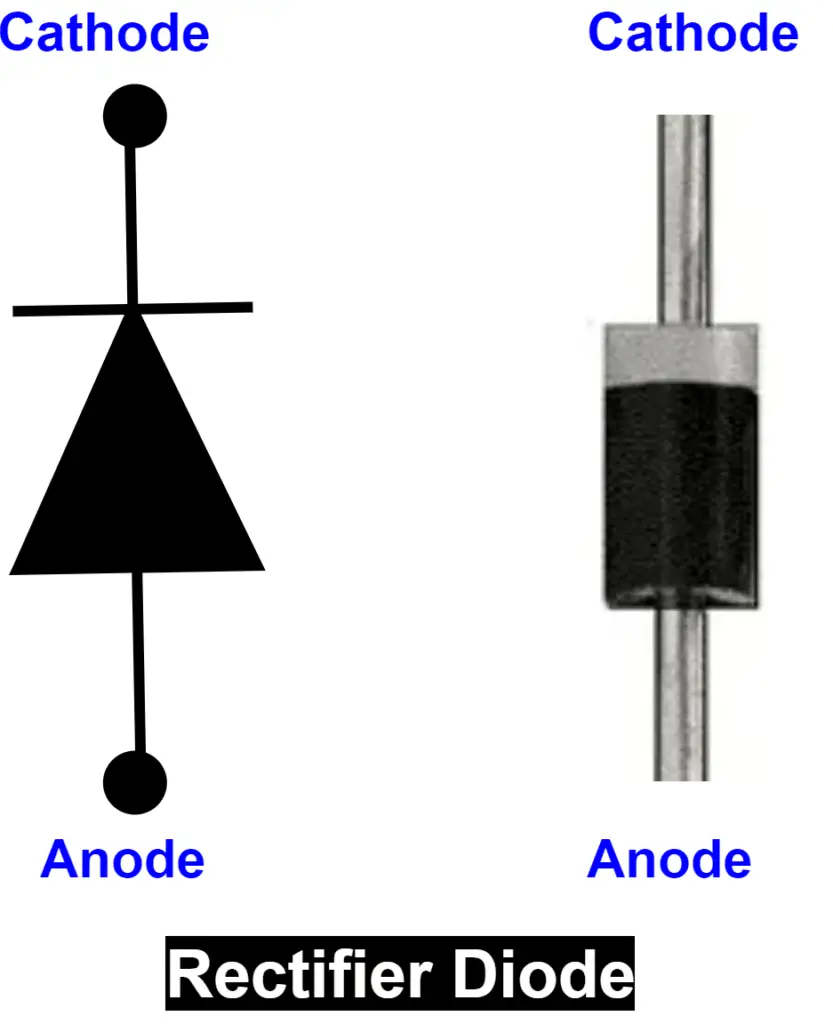
These diodes are used to rectify AC power inputs into power supplies. They can rectify current levels going from an amplifier up. If low voltage drops are required then Schottky diodes can be used, however, usually, these diodes are PN junction diodes.
Applications
Power supplies to electronic circuits.
9. PIN Diode
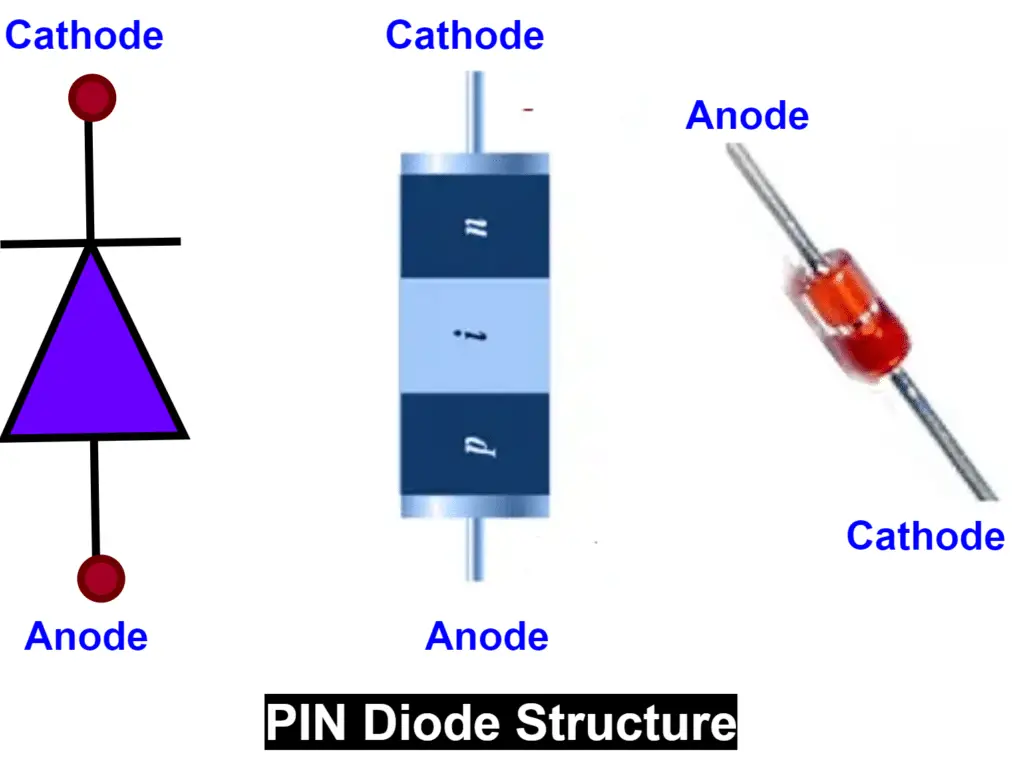
In the PIN diode, between layers P and N, a pure semiconductor material is known as “I” (Si, or Ge intrinsic material). Layer P and layer N are heavily doped, so they function as an ohmic contact, while the intrinsic “I” layer functions as an insulator, so no current flows through it. As a result, the PIN structure is very useful in RF switching and photodiodes.
This type of diode has areas of P-type and N-type silicon, but between them is an intrinsic semiconductor area (non-doped). As a result, the depletion region becomes larger.
PN junctions are the most common type of diode used today.
Many electronic circuit designs incorporate this electronic component.
Applications
It is used in several applications, including radio frequency switches and photodiodes.
A diode can be made for low-current applications, such as radio frequencies, or a high current and high voltage for power applications.
10. Photo Diode
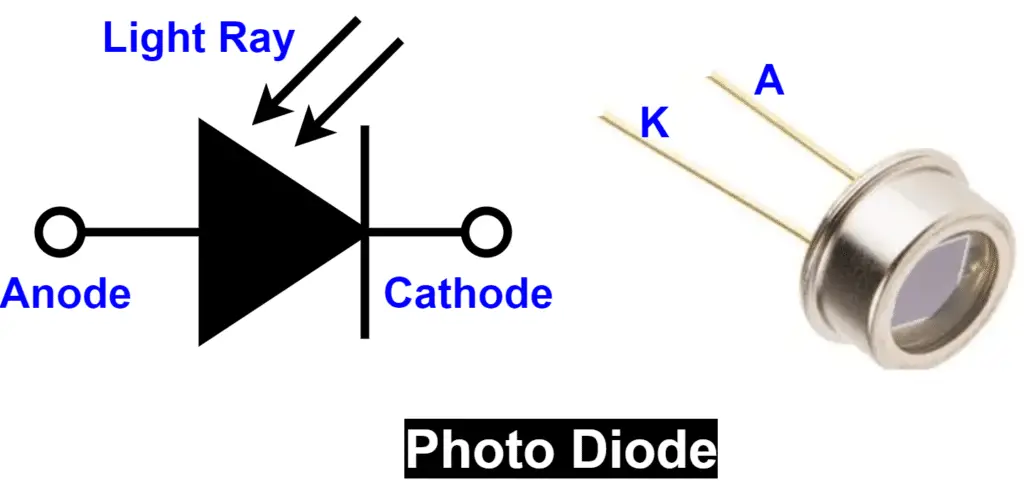
It is a diode sensitive to the incidence of visible or infrared light. It works in the reverse polarization zone, with a negative voltage at the anode and a positive voltage at the cathode. A photodiode behaves like a photovoltaic cell since it generates a small current when illuminated without an external source of power. So, it is helpful when detecting changes in light intensity.
Applications
There are many applications of the photodiode. Photodiodes are used in industrial measuring instruments and scientific instruments. They measure light intensity either by itself or as a measure of some other property (smoke, density). A photodiode can be used as a receiver of encoded data in an infrared beam, such as in-home remote controls.
They can be used in the form of an optocoupler, which allows signals to be transmitted between circuits without a direct metallic connection between them.
11. Backward Diode
The backward diode functions in a similar way as the tunnel and zener diode functions. Its operating voltage is much lower. It is a type of tunnel diode that has a less doping concentration at one side of the junction in comparison to another side of the junction.

A backward diode is essentially a tunnel diode, whose one side of the junction has relatively less doping concentration compared to the other side. In the forward bias, it functions as a tunnel diode and in the reverse bias, it functions as a zener diode.
- Read More: Peak Load Current of Backward Diode
Applications
It is used for the rectification of small voltage signals of high frequency. It is also used for RF mixers and multipliers because they have a very fast switching speed.
12. Transient Voltage Suppression (TVS) Diode
A TVS diode is a type of avalanche diode that is used to protect the circuit from voltage surges. It can handle higher voltage as compared to an avalanche diode.
The unidirectional TVS diode acts as a rectifier in forward boas and it acts as a surge protector in the reverse bias. A bidirectional TVS diode, manufactured as a single component, functions like two avalanche diodes opposing each other in series.

Thus, it operates both ways and therefore, it provides surge protection when it is used in parallel with a circuit.
ApplicationsApplications
- Surge Protection
- Protects electronic circuits from electrostatic discharge (ESD)
13. Vacuum Diode
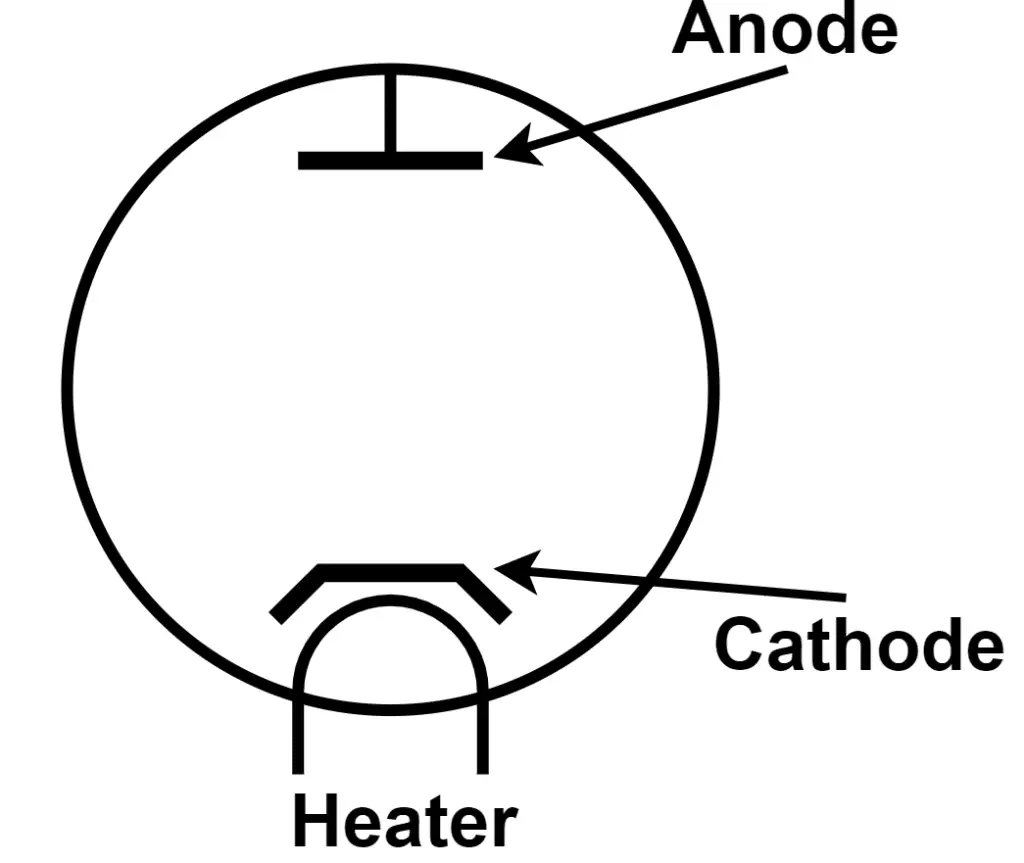
This type of diode has a vacuum tube and two electrodes-cathode and anode which are enclosed inside the vacuum tube. In forward bias, on heating the cathode, it emits electrons, and the anode which is at positive potential catches these electrons, and current flows between the anode and cathode. In reverse bias, the anode is held at negative potential and it repels the electrons, thus no current flow between the anode and cathode.
Applications
- Used in radios, microwave ovens, Television transmitters, and receivers
- Early Computers
- Satellite & radar communication
14. Shockley Diode
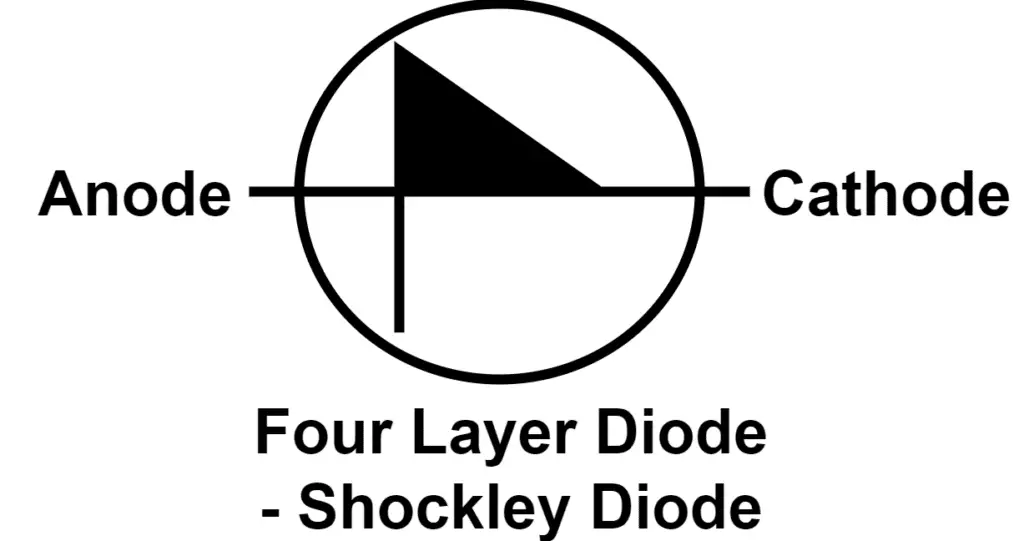
This diode has four layers and it is also called a PNPN diode. If you compare it to a thyristor, you will find that it is just like a thyristor without a gate terminal. The Shockley Diode conducts when it is forward-biased.
The diode has two states of operation- conducting and non-conducting states. It remains on once it is forward biased and remains in this state till it gets forward biasing voltage.
Applications
- As Relaxation Oscillator
- As Trigger Switch
15. Step Recovery Diode

The step Recovery diode has unusual doping. It has an extremely small doping density near the junction area and, therefore has small numbers of charge carriers near the junction and leading to fast switching of the diode from ON state to OFF state.
Applications
- Used as a charge controller switch
- Used for high-speed pulse shaping, frequency multipliers, high-frequency harmonic generators
- Used in Voltage controlled oscillators (VCO)
- The pulse generator in microwave applications
16. Gold Doped Diode
Gold is used as a dopant in these diodes. The gold diode has very less leakage current in reverse bias and its switching speed is very fast. The gold facilitates faster recombination of minority carriers.
Application
It is widely used in the control of storage time in small-area diffused silicon computer diodes.
18. Super Barrier Diode
The super barrier diode is used as a rectifier diode. The super barrier diode has a low forward voltage drop like the Schottky diode with surge handling capability and low reverse leakage current like the P – N junction diode.
Applications
- For high power, fast switching, and low-loss applications
- Next-generation rectifier with the low forward voltage
18. Peltier Diode
Peltier or Thermal diode permits the flow of heat in one direction. Its thermal resistance is different in both directions. A Peltier diode has different thermal resistance for heat flow in one direction when compared to heat flow in the other direction.
Applications
- For heat monitoring in microprocessor
- For cooling effect in refrigerators
19. Crystal Diode
The crystal diode is a type of point contact diode. The crystal diode or Cat Whisker diode has a small point junction formed between a metal wire & N-type semiconductor crystal. Cat whicker is a thin springy wire of phosphorous bronze or tungsten material and it makes a point contact with an N-type semiconductor, therefore it is called a point-contact diode.
The junction area in the crystal diode is very less, therefore it stores a very low charge. The low charge stored at the junction makes this diode a fast-switching device.
During the manufacturing of a crystal diode, A large current is passed through a cat whisker wire to form a P-region upon the N-type semiconductor. Thus. small junction functions as a P-N junction.
Applications
- Used for rectification of low-voltage signal
- In microwave mixer and detectors
- Used in radio receiver as a detector
20. Point Contact Diode
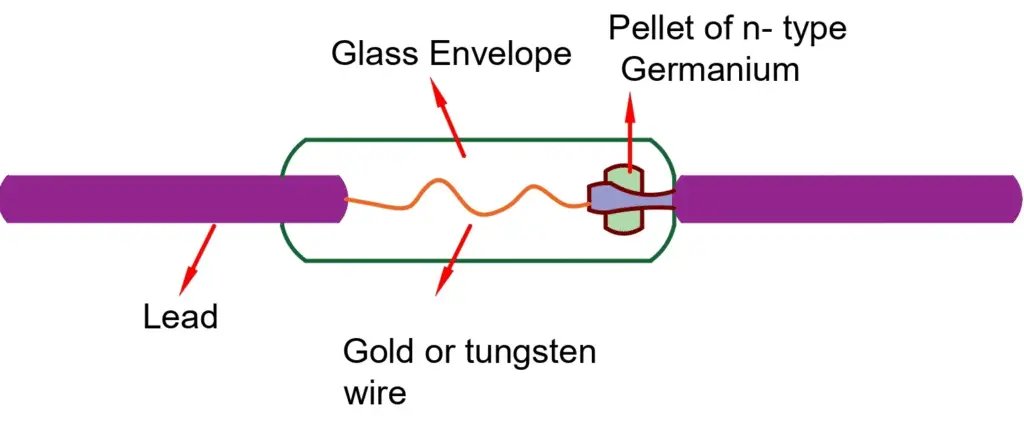
A point contact diode is formed by touching a gold or tungsten wire with an N-type semiconductor and passing a high current through it. By this process, a small PN junction area is formed around the edge of the wire,
Applications
- Used in high-frequency circuits
- Detector circuits
- Radiofrequency mixer
- Video detector
- Envelope detector
21. Gunn Diode
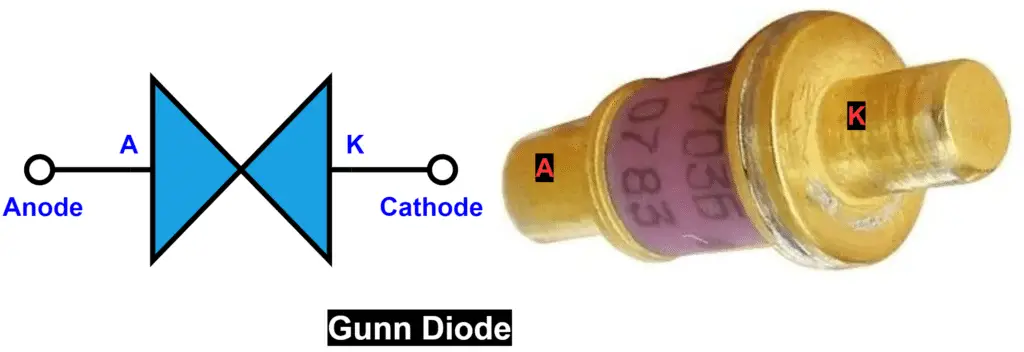
Gunn diode has only n-type semiconductor material. It consists of two electrodes with Gallium Arsenide and Indium Phosphide. The depletion region of two N-type materials is very thin. Gunn diode has negative differential resistance, therefore it is also called a transferred electron device.
The current increases in the circuit when we increase the voltage. However, at a certain voltage, the current starts exponentially decreasing. Thus, the Gunn diode has a negative differential resistance.
Applications
- Used in oscillators circuits
- Radio communications, Radar
- Microwave transmitters
- Microelectronics
- Used in laser beam
22. Small Signal Diode
The small signal diodes are very small in comparison to power diodes. The cathode of the diode is marked with black or red color. The diode is housed in a glass tube to protect it from contamination. The diode is enveloped with glass, therefore it is also called as Glass Passivated diode. You have ever used the diode 1N4148, this is a small signal diode.
These types of diode have a very small current carrying capacity and a lower power dissipation. The typical current carrying capacity and power dissipation are 150 mA and 500 mW respectively. The small signal diodes are used for very low current applications at high frequencies.
Applications
- Used for small current at high-frequency applications like TV, Radio
- Switching and clipping applications
- Used for snubbers, rectifiers, and wave-shaping circuits
- Used in limiter circuit
- Used in regulated power supply circuits
23. Large Signal Diode
A large signal diode has a larger PN junction area. The larger PN junction area means the diode has more current carrying capacity and more reverse blocking voltage. both these features make the large signal diodes suitable for rectification applications i.e. converting AC to DC. However, these types of diodes are not suitable for high-frequency applications.
Applications
- Used in rectifier and converter circuits
- Used in Battery Chargers
24. IMPATT Diode
The full name of the IMPATT diode is Impact Ionisation Avalanche Transit Time. IMPATT diode is a high-power diode used in microwave applications. This diode has a negative resistance characteristic and is used as an oscillator at microwave frequency. The operating frequency range of the IMPATT diode ranges from 3 – 100 GHz.
Applications
- Used as a parametric amplifier and Oscillator at microwave frequency
- Telecommunication transmitter and receiver
- Intruder alarm
25. TRAPATT Diode
The full form of the TRAPATT diode is the TRApped Plasma Avalanche Triggered Transit diode. These diodes operate between hundreds of MHz to GHz. The diodes usually have n+- p-p+ or p+-n-n+ structures with n-type depletion region, width varying from 2.5 to 1.25 µm. The TRAPATT diodes are high peak power diodes.
Applications
- Used in low-power Doppler radars
- As an oscillator for radars
- Microwave beacon landing system
- Radio altimeter
- Phased array radar, etc.
26. BARITT Diode
The full form of the BARITT Diode is the BARrier Injection Transit Time diode. Like IMPATT diodes, these diodes have long drift regions. The forward biasing cause the carrier injection in BARITT diodes.
Applications
- Used in Burglar alarm
- Used in small signal amplifier
- It is used in an oscillator circuit